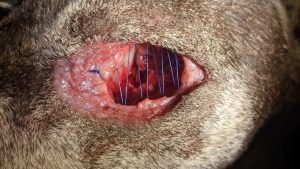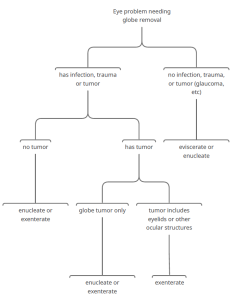Eye surgery
Enucleations
Overview
Eye lesions can be terribly painful and cause decreased production. Enucleation rapidly removes the pain. Enucleation methods are relatively similar across species.
- Evisceration – removal of globe contents; leaving the globe, the extraocular muscles and other structures
- Evisceration is performed when implants will be used to make the eye look normal
- Evisceration is unusual in veterinary medicine
- Enucleation – removal of the globe; leaving the extraocular muscles and other structures
- Enucleation is indicated when the globe is damaged but there is no risk of neoplasia or infection that could be in the extraocular tissues
- Enucleation may leave less of an empty socket as compared to exenteration
- Enucleations may be performed subconjunctivally (dissect between the globe and the conjunctiva; eyelids open) or with the eyelids closed and between the globe and the muscles.
- Exenteration – removal of everything in the orbit
- Exenteration is indicated when there is a risk of neoplasia or infection in the extraocular tissues
- Exenteration is common in large animal species
- Orbital prostheses
- In vet med, a gray silicone ball that is placed in the socket and covered by the eyelids which are sutured closed
- The goal is to create a more normal appearance; it usually doesn’t look at all normal
- Foreign objects create a risk of persistent infection and should only be used in very clean situations
When we talk about cattle enucleations, we generally mean exenterations.
There are a few main differences between small and large animal enucleations:
- For LA, we typically perform surgery in the standing animal (safer for the animal than general anesthesia). Horses are sedated with detomidine/butorphanol or similar combinations. Cattle will often not require sedation; if needed, xylazine works well. Head restraint and local blocks are required in both species.
- In LA, we do not typically ligate the artery (with a complete bony orbit, this is hard). That means we have to create hemostasis in other ways. Cows like to clot well but this is an artery so even cattle will continue to bleed. By suturing the lids closed, we create a closed space. With enough bleeding, the pressure builds up and stops the arterial flow. The animal will have a bulging eye for a bit but this resolves after the bleeding stops. We typically skip the subcutaneous layer if bleeding is profuse and just close skin quickly.
- Prostheses are rarely used in LA. These can only be used in clean sockets (not tumors or infections).
If the artery is ligated, you can also try a trampoline suture. The premise is that this will minimize the sunken appearance by providing a scaffold for fibrous tissue.

Watch this video as is first to get a general idea of how ocular SCC is handled surgically in cattle.
Then watch again with my comments (which doesn’t work unless they remove the restriction) – https://youtu.be/-ejfSxOQhoA
Whenever possible, stay close to the eyelid margins to enable closure! If closure isn’t possible, packing or stenting (tieing on a bandage to provide pressure) will be needed to control hemorrhage.
Aftercare
Aftercare is routine for any surgery – sutures are removed in 10-14 days and any infection managed through drainage. The most common complication is infection.
Typically animals adapt well to unilateral enucleation. Some can even tolerate bilateral enucleation if maintained in a consistent environment.
Key Takeaways
- Exenteration is what we really perform in LA; we call it enucleation
- Rarely do we try to ligate the ocular artery; we close the skin fast to create pressure for hemostasis
- Complications include infection and dehiscence. Occasionally too much skin is removed and closure can be challenging.
Eye surgery decision tree- downloadable version

Resources
Field surgery of the eye and periorbital tissues, VCNA, 2008- nice step by step overview
Ocular field surgery in ruminants, Intl J Vet Med, 2015- see enucleation surgery blocks and techniques;. also discusses SCC risks
Bovine enucleations : case info and complications – CVJ, 2010- especially useful for finding out what complications are common
Surgical treatment of the eye in farm animals, 2010 VCNA pgs 460-462, 471-end- has a bit more about exenteration vs enucleation how to
Enucleation in companion animals ,Irish Veterinary Journal Volume 61 Number 2- the SA version
More videos

